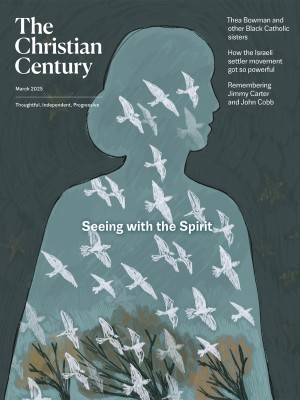March 9, Lent 1 (Psalm 91:1–2, 9–16; Romans 10:8b–13; Luke 4:1–13)
God chooses to draw near—and to draw us out of ourselves.
Nearness is more than proximity. Strangers can stand side by side on a subway platform while remaining galaxies apart. Lovers can be on opposite sides of an ocean and still be one in heart and mind. In this Sunday’s gospel text, Jesus is far away from God. He is in a desert place. He is tempted by the devil. And yet, God still draws near. When Jesus confesses the convictions of his heart, his words are not only enough to keep temptation at bay. They also reveal the nearness of two—Father and Son—who are perfectly aligned and near in a way that transcends proximity.
It is helpful to keep the paradoxical nature of nearness in mind as we turn to this week’s epistle lesson. This text from Romans can be read as a theological reflection on nearness. Through the gift of the Word made flesh, God draws near to us and we—by grace—are bestowed with the capacity to draw near to one another. In six concise verses, Paul reveals who God is and who we—graced by the gift of God’s preeminent Word, Jesus Christ—may now choose to become.
Read our latest issue or browse back issues.
“The word is very near to you,” says Moses (Deut. 30:14). In Paul’s hands this cherished verse implies that God chooses to be something other than spectator or voyeur. A spectator stays seated in the stands. A voyeur remains crouched behind the keyhole. In the Word made flesh, God comes alongside us, close enough to touch. God kneels to wash our feet and then, for us, takes on the cross. When we—in grateful response—take the Word made flesh into our hearts, our whole lives become oriented around a new center. The words of our mouths express our deepest convictions, and this allows us to become more for each other than either acquaintance or stranger. An acquaintance merely glances, while a stranger is free to turn away. Yet with God’s Word in our hearts, we stand face to face. We begin to see one another with the eyes of Christ.
In the passage Paul borrows from Deuteronomy 30, Moses reassures the Israelites that the word of the law is not beyond them. Its meaning is accessible, and the performance of its command is feasible. The word of the law is within their grasp and, in just this way, God draws near even in their desert place. Paul reassures the young Christians in Rome that the gift is greater than they ever imagined. The Word made flesh in Jesus Christ is a living Word brought down from heaven and raised up from the dead. God takes this circuitous path in order to draw near to us in a way that the law alone never could.
This is only part of the story. God—the one who chooses to draw near—also draws us out of ourselves with the recognition that our Lord is Lord of all. There is no qualification to God’s promise in this week’s psalm: “Those who love me, I will deliver. I will protect those who know my name.” The living Word resides in our hearts, and we perform our new reality by speaking into existence words of grace and peace and love. As we do, we swear our allegiance. We bind ourselves to the very one who first drew near to us.
And when this happens to us—when we are steeped in the living Word—there is “no Jew or Greek,” as Paul declares here for the fifth time in Romans. The ties of kith and kin, which separate as quickly as they bind, give way to a new kind of nearness: a tighter knot of shared conviction and reciprocal words truly spoken. The circuitous path is complete. God who chooses to draw near to us empowers us to draw near to those who once seemed impossibly far.
Years ago, my wife and I brought a new puppy home. We took Norm to a trainer, who spent most of her time training us. One of our lessons was what we were to do when he, out of the enthusiasm of youth, found it impossible to obey. “Leash him to a closet door where he can still see you,” she said. “And then just ignore him. When he settles down, release him and rub his ears.”
It worked like a charm. Every time we employed her method, Norm was magically transformed into a model of obedience. At our next lesson, I said, “This is amazing! How on earth can it be this easy?”
“It’s simple,” said our trainer. “Your puppy wants nothing more than to be near you. He will do anything to make that happen.” A sudden, almost theological insight went through me like a charge. My eyes flooded with tears. Nearness is a puppy’s heart’s delight; an ecstatic end in itself. The same can be said of God and of all who choose to gather in God’s name.





